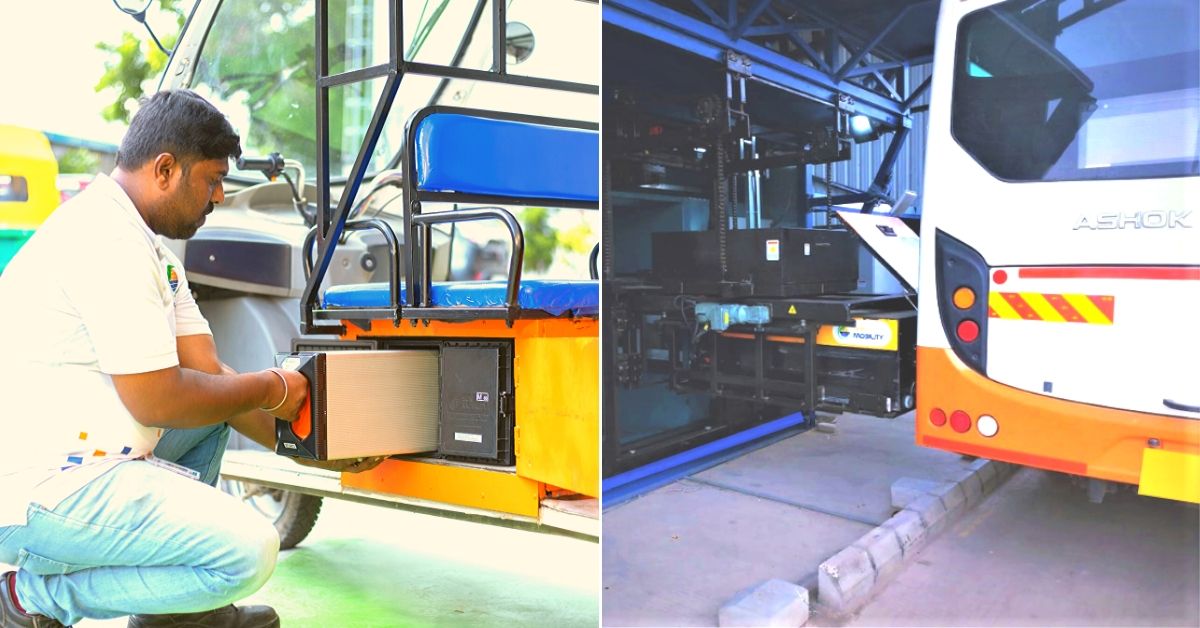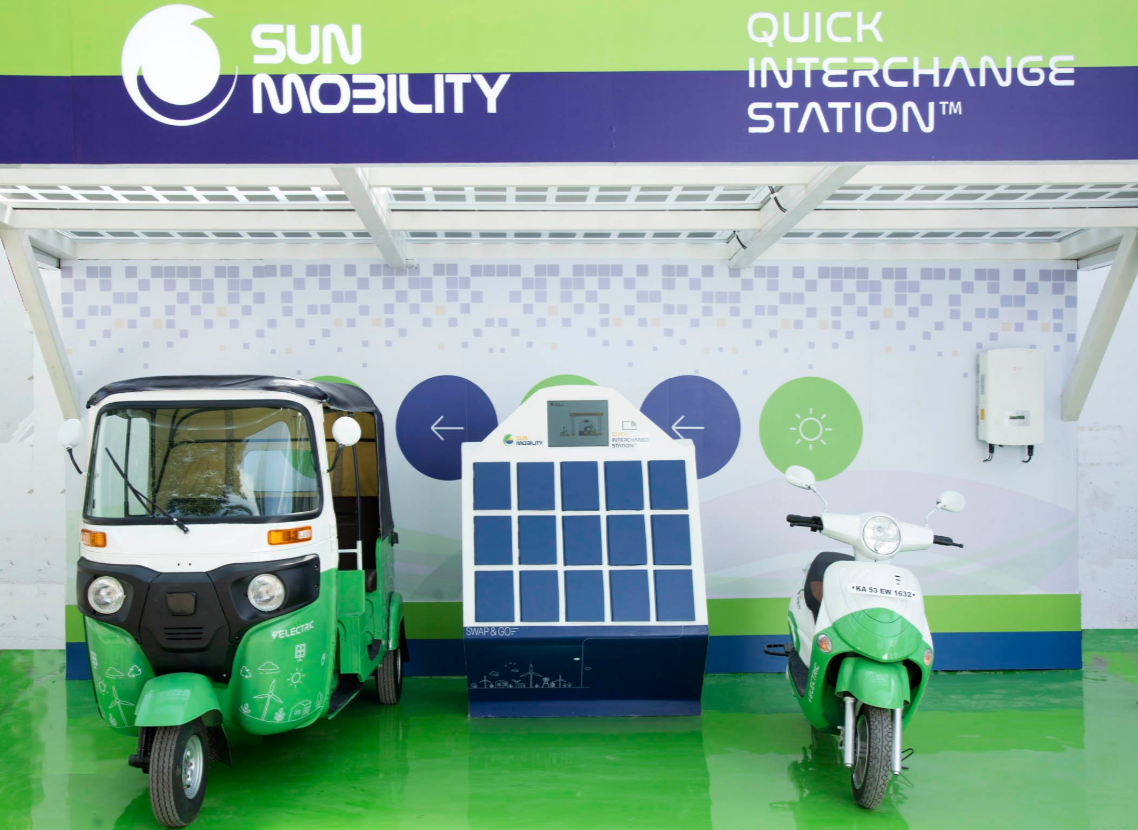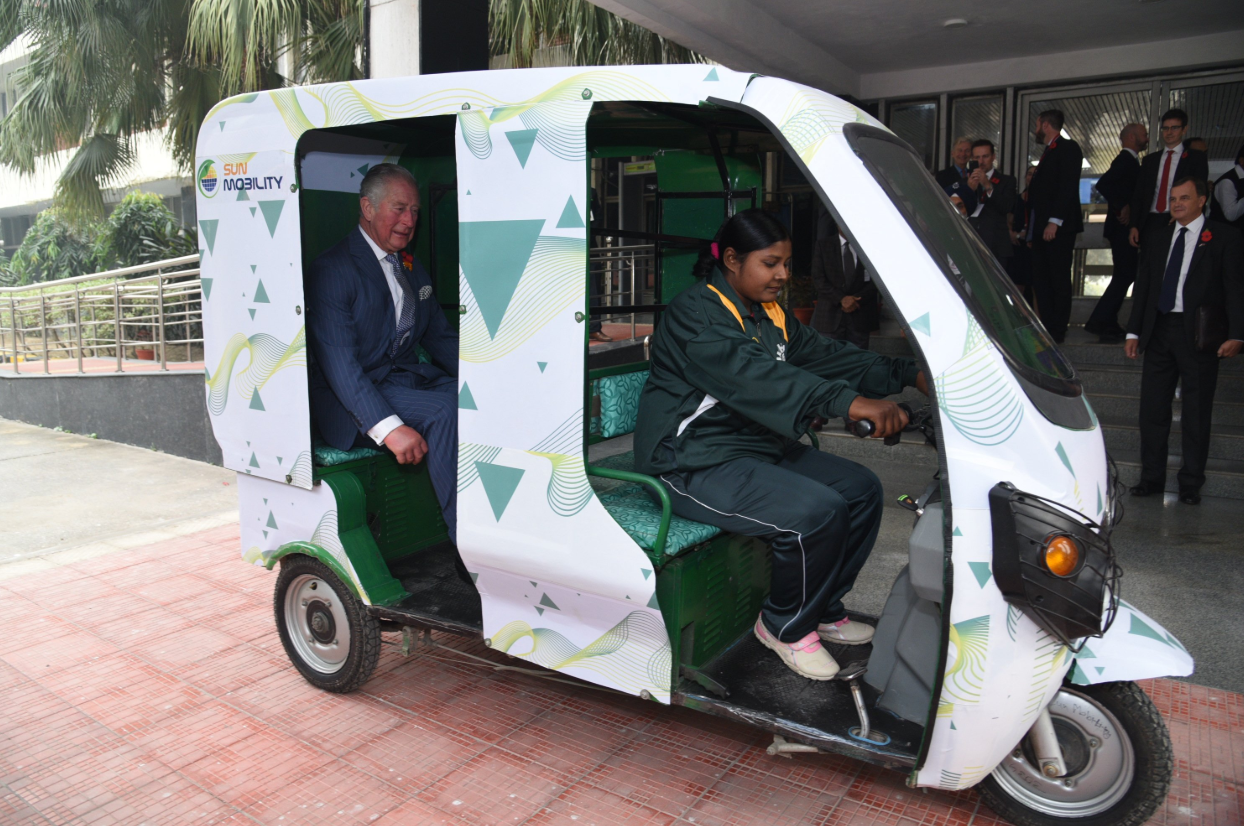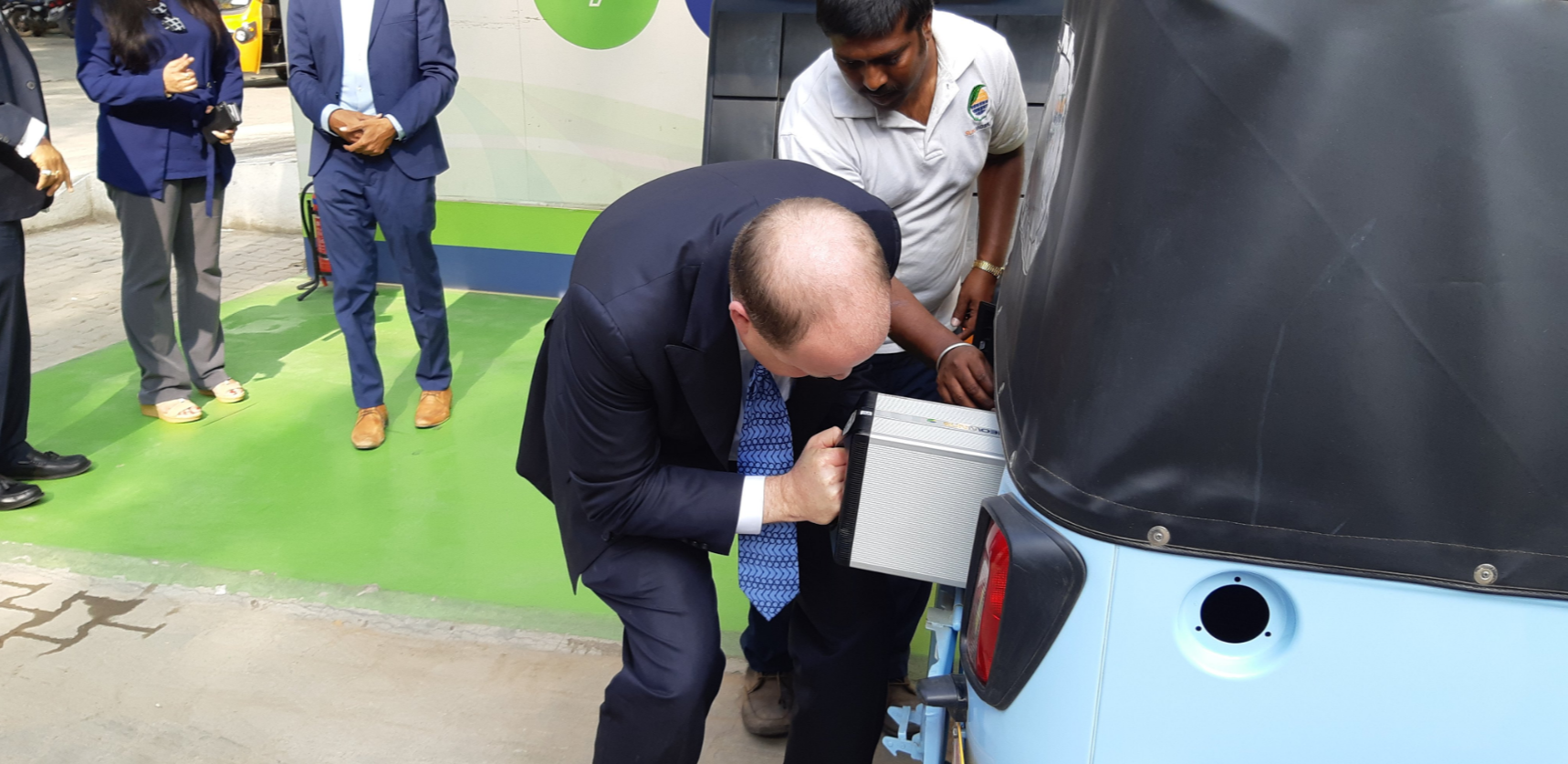B’luru Startup’s Swappable Tech Can Turn India’s Buses & Autos 100% Electric
With SUN Mobility’s revolutionary battery technology, one can ‘refuel’ in a matter of minutes — just like we do at the regular petrol/diesel stations and much faster compared to the conventional charging setup that takes anywhere from 1-5 hours! #ElectricFuture #DriveGreen

Nearly 85 per cent of urban commuters in India depend on either two/three wheelers or buses to travel. Thus, transitioning to electric vehicles has become more important. Yet long-standing structural concerns remain unresolved rendering e-vehicles an unviable alternative to many.
For example, the total cost of owning an electric vehicle remains significantly higher than internal combustion engine (ICE) vehicles. Another concern is range-anxiety combined with inadequate charging infrastructure, followed by the extended time it takes to recharge an electric vehicle. While charging takes anywhere up to four hours, consumers are used to filling up their fuel tanks in less than five minutes.
In comes SUN Mobility, a Bengaluru-based startup, with answers to these concerns.
“With SUN Mobility’s revolutionary battery swapping technology, one can ‘refuel’ in a matter of minutes just like at the regular petrol/diesel stations and much faster compared to the conventional charging setup which takes anywhere from 1-5 hours. Our lightweight, swappable Lithium-ion batteries are compact, have long life, are upgradeable and have higher utilisation potential for shared mobility applications,” says Yuvraj Sarda, Head of Strategy at SUN Mobility, in an interview with The Better India.
Earlier this month, SUN Mobility entered into a partnership with small commercial vehicles (three-wheeler) manufacturer Piaggio.
The startup will integrate their swappable battery technology in the Italian company’s upcoming range of electric vehicles. The network of quick interchange stations will enable the electric three-wheeler (autorickshaw) drivers to swap their batteries in under two minutes, thereby addressing concerns around range limitations and long refuelling time.

The evolution from CNG to electric for auto rickshaws can particularly help cities like Delhi to address its vehicular pollution problem. Even though CNG is a low emission fuel replacement, they still emit a significant amount of greenhouse gases.
“This partnership with SUN Mobility is a step forward towards providing easy, cost effective and eco-friendly last mile transportation. SUN Mobility’s battery swapping solution will help us in fulfilling our vision of creating a sustainable mobility ecosystem without having to worry about the energy infrastructure,” says Diego Graffi, MD and CEO of Piaggio Vehicles.
The Technology
SUN Mobility has adopted the approach of separating batteries from the vehicles with these swappable batteries alongside developing Quick Interchange Stations (QIS) or charging stations. Since batteries contribute up to 50 per cent of the final cost of the EV, they have delinked vehicle usage from battery charging.
Take the example of Circuit S electric bus manufactured by Ashok Leyland in Ahmedabad, which has a unique ‘battery swap’ technology developed by SUN Mobility. The bus, after its round-trip, aligns itself in front of the QIS and the Automation from the QIS removes the drained battery from the bus and swaps it with a charged battery.
The participants get a first hand experience of how a battery swapping works for ebuses at this @SUN_mobility and @ALDefence facility for #Janmarg #Ahmedabad #EVConnect @WRIIndia@ShaktiFdn @GoElectricIndia @WorldResources #EV #ElectricVehicles #Ebuses @WRIRossCities @madpai pic.twitter.com/kyi3canEIL
— Amit Bhatt (@amitbhatt4u) September 23, 2019
The QIS houses chargers and batteries which get charged throughout the day thereby ensuring there is no sudden load surge during any time in the day. Instead of worrying about how much energy a standard lithium-ion battery in an e-bus can last on a single charge, these vehicles can make a pit stop after completing their circular route at a QIS. There, a fully-automated system will swap the smart batteries under 2.5 minutes and replace them with new ones.

“This is how battery swapping technology enables the vehicles to become cost neutral and brings about a price parity between EVs and ICE vehicles. For the first time, our battery swapping technology offers an economical, sustainable and highly-scalable solution for accelerating electric mobility in India, that can be easily replicated globally too,” he adds.
Yuvraj lists some the key features of the Smart Batteries:
Lightweight: Weighing in at just around 13 kgs for a 2/3 wheeler battery, and 600kgs for a bus battery, these Smart Batteries free up space for more passengers and also improve efficiency.
Modular: 1, 2 or 3 battery packs can be used for different range/performance requirements or for different applications (For e.g. 1 battery for a two wheeler, 3 for an eAuto)
Long life: Advanced Lithium-ion cell technology allows up to four times longer life than a conventional Lithium battery.
Optimal Performance and Connectivity: Three on-board computers, with Advanced Battery Management System and GPS/GSM/Bluetooth connectivity helps drivers keep a constant check on the battery vitals, track batteries in real time, enables digital authentication, facilitates station operations and ensures service delivery optimisation.
High Level of Security: Tough, tamper-proof exterior with electro-mechanical lock, and over 30 onboard sensors ensures security against misuse/theft.
Robust Design for Indian conditions: Protection against rough handling, tampering as it is designed from the ground up for Indian operating environment.
To charge these swappable batteries you need a QIS, where depleted batteries can be replaced with fully charged ones in a matter of minutes. The QIS charges and cools the batteries simultaneously so that they are conditioned for long life and high performance.
E-innovative solution 4 E-mobility
Quick Battery swapping solution to promote E-vehicles in India. pic.twitter.com/6s4brP8QZf— Syed Akbaruddin (@AkbaruddinIndia) March 31, 2019
“The QIS is easy to install (takes a day), modular, has edge computing, advanced thermal management system and is always connected to our cloud servers. It automatically runs diagnostics and cooling (if required) when the battery is placed back for charging. Since SUN Mobility offers ‘Battery As A Service’, the consumer pays only for the energy consumed,” says Yuvraj.
SUN mobility has developed two kinds of QIS’ – one for electric two and three wheelers and another for electric buses. Compared to four-eight hours of conventional charging time, each smart battery can be swapped in under three minutes. Each QIS for two and three wheelers can do more than 200 battery swaps per day while a QIS for eBuses can do more than 300 swaps per day.

“Our current network of QISs is operational in Gurgaon for a small fleet of electric three-wheelers from SmartE. We are expanding the same to six cities over the next five months to cater to fleets of electric two and three wheelers,” informs Yuvraj.
Also Read: Adopted by Ahmedabad, ‘Battery-Swapping’ Could Revolutionize India’s E-Bus Scene
SUN Mobility’s unique battery swapping technology offers tremendous scope for converting public transport and its feeder services to electric. It’s already happening in Ahmedabad with Ashok Leyland’s Circuit-S public buses backed by SUN Mobility’s battery swapping technology.

“With current high costs of batteries and long recharging times, electric mobility is neither financially nor operationally viable. Also, charging infrastructure business (setting up charging stations at public places) for electric vehicles is also not financially viable until there is enough demand to ensure high utilisation of charging equipment,” says Yuvraj.
What SUN Mobility is looking to do is hit two birds – address range anxiety and develop a viable financial ecosystem for charging infrastructure – with one stone. If they can scale up their operations rapidly, India’s total transition to electric could happen a lot sooner.
(Edited by Saiqua Sultan)
Like this story? Or have something to share? Write to us: [email protected], or connect with us on Facebook and Twitter.
If you found our stories insightful, informative, or even just enjoyable, we invite you to consider making a voluntary payment to support the work we do at The Better India. Your contribution helps us continue producing quality content that educates, inspires, and drives positive change.
Choose one of the payment options below for your contribution-
By paying for the stories you value, you directly contribute to sustaining our efforts focused on making a difference in the world. Together, let’s ensure that impactful stories continue to be told and shared, enriching lives and communities alike.
Thank you for your support. Here are some frequently asked questions you might find helpful to know why you are contributing?


This story made me
-
97
-
121
-
89
-
167













